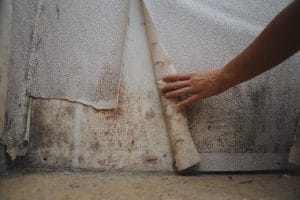Steps to Cleaning Up Mold After a Flood
FloodingFlooding is the overflow or accumulation of water in areas t... More can be a cause of moldMold is a type of fungus that grows in damp or humid conditi... More growth inside the home. A moldMold is a type of fungus that grows in damp or humid conditi... More problem can develop quickly, within 24 to 48 hours, if the dampness has not been addressed. It’s important to clean up any moldMold is a type of fungus that grows in damp or humid conditi... More sporesSpores are microscopic reproductive units of fungi or mold t... More after a flood. Here are the steps to eliminating the pesky moldMold is a type of fungus that grows in damp or humid conditi... More.
A home can flood due to a number of causes. Adverse weather conditions, such as hurricanes, major thunderstorms and similar events, can introduce moisture into the home. In such cases, a homeowner needs a functional sump pumpA sump pump is a pump installed in a basement or crawlspace ... More, a solid foundation, and an emergency weather plan.
When the home’s foundation is damaged with cracks or other flaws, water can enter through the floors. Since the foundation is built on the ground, it is susceptible to oversaturation from rainwater or snowmelt. Homeowners are advised to repairRepair is the act of fixing or restoring damaged property, m... More a damaged foundation to prevent floods.
Appliances that utilize water can malfunction and cause a flood. Water heaters, dishwashers, and washing machines that break or are improperly connected can spew water all over the home. At the first sign of issues, a homeowner should repairRepair is the act of fixing or restoring damaged property, m... More or replace the appliance to avoid floodingFlooding is the overflow or accumulation of water in areas t... More.
The chances of floodingFlooding is the overflow or accumulation of water in areas t... More rise significantly when the gutters are clogged. Dirt, leaves, twigs, and other natural debris can block the flow of water into the gutters and downspout, thereby causing the water to potentially seep into the interior parts of the home. Cleaning gutters regularly is recommended.
A broken pipe, too, can cause indoor floodingFlooding is the overflow or accumulation of water in areas t... More. It takes just minutes for a ruptured pipe to gush several gallons of water into the home. Fix minor leaks promptly to prevent floods. Also, know the location of the home’s main water shut-off valve in the event of an emergency.

A moldMold is a type of fungus that grows in damp or humid conditi... More problem can develop quickly, within 24 to 48 hours
How to determine if you have moldMold is a type of fungus that grows in damp or humid conditi... More
If the home has been affected by water damage, moldMold is a type of fungus that grows in damp or humid conditi... More is a likely outcome. MoldMold is a type of fungus that grows in damp or humid conditi... More sporesSpores are microscopic reproductive units of fungi or mold t... More are living organisms that require few nutrients to survive: moisture, oxygenOxygen is a chemical element essential for combustion and li... More, and darkness. In order to completely eliminate the moldMold is a type of fungus that grows in damp or humid conditi... More, it is essential to find and repairRepair is the act of fixing or restoring damaged property, m... More the moisture source.
Identify the moisture source
When the home floods, the first step a homeowner should take is to remove the floodwater. Use a mop, bucket, thick towels, a wet vac, or a combination of these tools to remove the water. Once the water is cleared out, look for entry points through which the water leaked.
Breach points through which moisture can intrude include cellar windows, cracks in the basement wall, or a leaky roof. A homeowner must fix the issues that allowed water to get inside. Replace the leaky cellar windows, caulk the cracks in the foundation, or repairRepair is the act of fixing or restoring damaged property, m... More the damaged rooftop shingles.
Use a biocide
The flooded area will likely be teeming with moldMold is a type of fungus that grows in damp or humid conditi... More sporesSpores are microscopic reproductive units of fungi or mold t... More and various waterborne bacteria. A biocide is a chemical disinfectantA disinfectant is a chemical substance used to kill or inact... More that kills microorganisms, such as fungiFungi are a group of organisms, including mold, mildew, and ... More, bacteria, and virusesViruses are microscopic infectious agents that can only repr... More. Since moldMold is a type of fungus that grows in damp or humid conditi... More is fungiFungi are a group of organisms, including mold, mildew, and ... More, the biocide will kill the moldMold is a type of fungus that grows in damp or humid conditi... More sporesSpores are microscopic reproductive units of fungi or mold t... More growing in the flooded parts of the home.
One of the most effective and widely available biocides is bleach. A homeowner will likely have a supply of bleach in the home. Dilute the bleach with water, following the instructions on the bottle, and apply the solutionA solution is a homogeneous mixture of two or more substance... More to the moldy concrete walls and floors.

Bleach is commonly marketed as a solutionA solution is a homogeneous mixture of two or more substance... More for eliminating moldMold is a type of fungus that grows in damp or humid conditi... More
Although the bleach will kill any living moldMold is a type of fungus that grows in damp or humid conditi... More sporesSpores are microscopic reproductive units of fungi or mold t... More, the dead sporesSpores are microscopic reproductive units of fungi or mold t... More still pose a threat to the health of the home’s occupants and should be removed. Wipe away the dead moldMold is a type of fungus that grows in damp or humid conditi... More sporesSpores are microscopic reproductive units of fungi or mold t... More with a paper towel. The bleach and water solutionA solution is a homogeneous mixture of two or more substance... More is suitable for use in unfinished rooms.
Finished rooms in the home that have undergone water damage require a different and more complex approach. A biocide is not recommended, since the bleach solutionA solution is a homogeneous mixture of two or more substance... More can permanently discolor carpet fibers and furnishings. Plus, carpet and drywall are porousPorous describes a material that contains small openings or ... More and harbor the moldMold is a type of fungus that grows in damp or humid conditi... More sporesSpores are microscopic reproductive units of fungi or mold t... More.
In the event a finished room with carpeting and drywall becomes flooded, the moldMold is a type of fungus that grows in damp or humid conditi... More sporesSpores are microscopic reproductive units of fungi or mold t... More can thrive behind the drywall and under the carpeting. Oftentimes, the moldMold is a type of fungus that grows in damp or humid conditi... More behind the walls or beneath carpets cannot be seen. Musty smells, however, should cause concern, since they are indicative of moldMold is a type of fungus that grows in damp or humid conditi... More.
Concealed moldMold is a type of fungus that grows in damp or humid conditi... More should be removed by a professional mold remediationMold remediation is the process of identifying, removing, an... More service. MoldMold is a type of fungus that grows in damp or humid conditi... More cleanup technicians utilize specialized equipment that can detect the hidden presence of moisture, such as behind walls, beneath wallpaper, and under carpeting. MoldMold is a type of fungus that grows in damp or humid conditi... More is never far from the moisture source.
Homeowners who follow the abovementioned steps can eradicate a minor moldMold is a type of fungus that grows in damp or humid conditi... More problem. When the moldMold is a type of fungus that grows in damp or humid conditi... More growth is severe, such as greater than ten by ten square feet, a moldMold is a type of fungus that grows in damp or humid conditi... More cleanup service should be contacted. Mold remediationMold remediation is the process of identifying, removing, an... More experts will perform repairs, dispose of damaged materials, and determine what should be replaced.
If moldMold is a type of fungus that grows in damp or humid conditi... More is a problem in your home or building after floodingFlooding is the overflow or accumulation of water in areas t... More, you should call a professional that provides high-quality mold removal as well as water damage restorationWater damage restoration is the professional process of clea... More.
MoldMold is a type of fungus that grows in damp or humid conditi... More growth is a possible outcome of a home flood. The water from the floodingFlooding is the overflow or accumulation of water in areas t... More already causes significant damage and the appearance of moldMold is a type of fungus that grows in damp or humid conditi... More will increase the damage and make the affected areas unsafe.
Professional technicians will address the floodingFlooding is the overflow or accumulation of water in areas t... More by removing the water and dryingDrying is the process of removing moisture from materials, s... More out the affected areas and materials, and they will also check for moldMold is a type of fungus that grows in damp or humid conditi... More growth. Calling moldMold is a type of fungus that grows in damp or humid conditi... More and water restoration professionals as soon as floodingFlooding is the overflow or accumulation of water in areas t... More occurs on your property will help limit the damage and prevent moldMold is a type of fungus that grows in damp or humid conditi... More growth.












